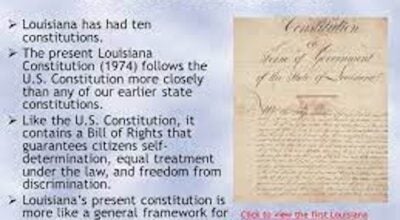Retirement plan was good one
Published 4:08 pm Thursday, July 11, 2019
The state Legislature had a golden opportunity in 2018 to give new state employees a better retirement system, but typical politics got in the way. Cindy Rougeou, executive director of the Louisiana State Employees Retirement System (LASERS), called it “a new retirement plan for a new generation.”
Rougeou, an extremely capable retirement official, said it would have taken about 30 years to phase the plan in and have all state employees on the hybrid plan. There were about 39,000 active members of LASERS and 48,000 retirees on the system last year.
Classified state workers (those under civil service) last year were earning an average of $44,737 annually, Rougeou said. Their annual retirement pay was only $25,000.
Currently, LASERS members contribute 8 percent of their pay into their defined benefit plan that promises them a monthly retirement check when they retire that is based on their salary and years of employment.
Under the hybrid plan sponsored by Sen. Barry Peacock, R-Bossier City, those hired after Jan. 1, 2020, would have contributed 4 percent of their income to their pensions. The other 4 percent would have gone into a “defined contribution” plan that workers could have invested in a 401
(k)-type plan.
Pensions would have been smaller under the hybrid plan, but the difference could have been made up with the investment part of the plan. In order to get full benefits, workers would have had to wait until they were 65 instead of 62.
The most desirable feature of the hybrid plan was it would have allowed employees to take their contributions, along with any earnings, to new jobs in the private sector. Many state employees are currently moving into better jobs. Now, they can only take their contributions with them, not any of the investment earnings.
Cost-of-living adjustments would have been paid automatically every other year under the new plan. Those cost-of-living increases are only given now from whatever is left from investment earnings, and that isn’t often.
Robert Travis Scott, president of the Public Affairs Research Council of Louisiana, said his organization checked nationally with other retirement systems. The nonpartisan research agency has studied retirement systems for years.
“Reviews for the (hybrid) bill were strong,” Scott said. “In many cases, this plan is better than the private sector provides.”
American Press employees in the mid-1980s, like current state employees, were on a defined benefit retirement plan. We were given an opportunity at that time to set up a 401 (k) investment plan, which gave us a hybrid plan like Peacock and Rougeou envisioned.
The late Ward “Buddy” Threatt, a colleague of mine, said we would be smart to contribute as much as possible (6 percent) to the 401 (k) and the company would match it with 2 percent. I took his advice, and it was one of the smartest financial moves I have ever made.
Private companies were turning to 401 (k) plans at the time and are still doing it today. That is why Louisiana business organizations recommended the Peacock-Rougeou plan.
Steven Procopio, PAR’s policy director, said he struggled to understand how anyone could be opposed to the hybrid plan.
However, Louis Reine, president of the Louisiana AFL-CIO, spoke against the plan last year. He claimed it offered a lower benefit at a higher cost and retirement age.
The Associated Press also reported that opposition from Gov. John Bel Edwards caused supporters to shelve the Peacock bill. Edwards’ spokesman gave the same excuse as Reine, a lower benefit at a higher cost and retirement age. Education organizations were also opposed.
The American Press eventually ended its defined benefit plan and a number of us received financial settlements based on our life expectancy. However, that 401 (k) is still there and it has been unbelievably rewarding.
Louisiana’s four current defined benefit retirement plans have assets totaling nearly $34 billion and $52.2 billion in liabilities, a level of debt close to $18.2 billion, which is called an “unfunded accrued liability,” or UAL.
The state created the systems in the 1930s and 1940s, and started paying pensions right away without funding the systems. Better efforts got under way in 1989 to begin reducing that debt, but it’s still an uphill battle.
What happened to Peacock’s bill last year is what happens every time Congress talks about reforming Social Security. Those who are enjoying their current benefits are not affected when reform involves only future employees, but they complain the loudest and politicians are quick to cave in.
Many of us who invested in 401
(k) programs could live off those annual withdrawals without any other income. That is how good they are, and it’s a shame future state employees won’t have an opportunity to enjoy those same benefits. Living on that $25,000 in current state employee retirement pay has to be tough in this day and age.
MGNonline/Pixabay





